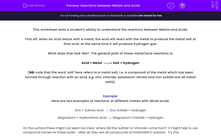In this activity, you will learn about the reactions between metals and acids.
Firstly, when an acid reacts with a metal, a metal salt of that acid will be produced. At the same time, it will produce hydrogen gas.
What does that look like? The general word equation for these metal/acid reactions is:
acid + metal → salt + hydrogen
Note that the word 'salt' here refers to a metal salt, i.e. a compound of the metal which has been formed through reaction with an acid, e.g. zinc chloride, potassium nitrate and iron sulfate are all metal salts.
Here are two examples of reactions of different metals with dilute acids:
zinc + sulfuric acid → zinc sulfate + hydrogen
magnesium + hydrochloric acid → magnesium chloride + hydrogen
So where did the 'sulfate' or 'chloride' come from? It might help to use compound names for these acids - after all, they are all compounds of hydrogen in solution.
So, hydrochloric acid = hydrogen chloride
sulfuric acid = hydrogen sulfate
nitric acid = hydrogen nitrate
If we look back at the two word equations above, we can now see where the zinc sulfate and the magnesium chloride have come from.
Here's another example:
copper + nitric acid → copper nitrate + hydrogen
could be rewritten as
copper + hydrogen nitrate → copper nitrate + hydrogen
In all of the above reactions, the metal has taken the place of the hydrogen in the acid and formed a metal salt. It's a type of displacement reaction.
Are you ready to have a go at some questions on this now?
Remember that you can look back at this page by clicking the red help button on the screen.









